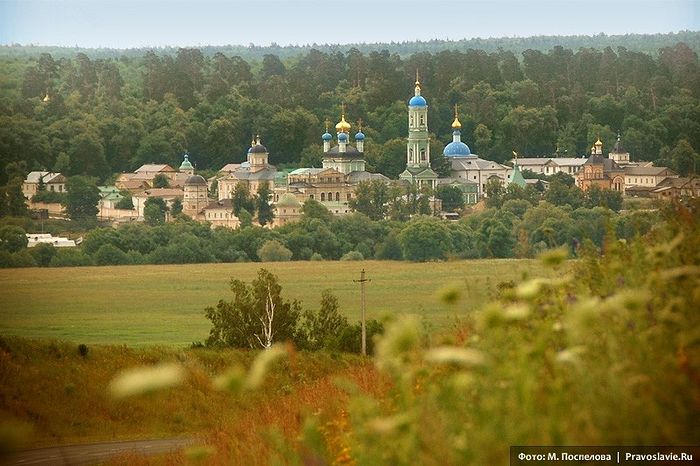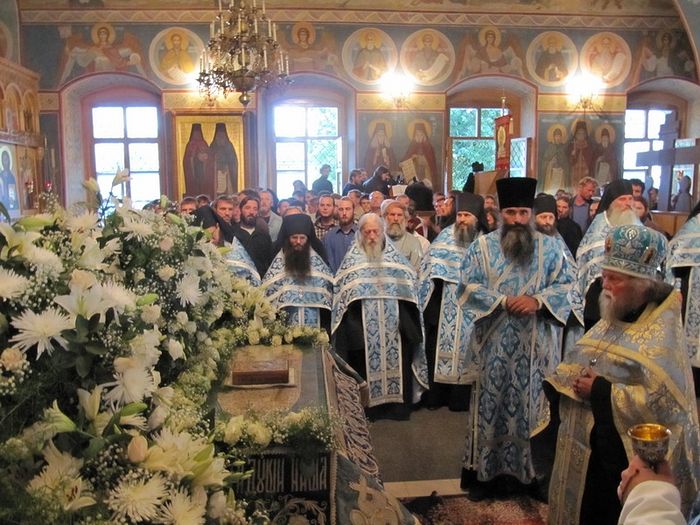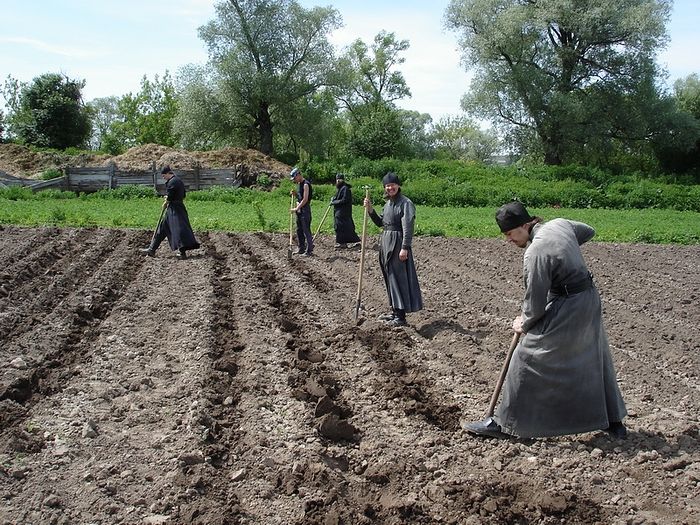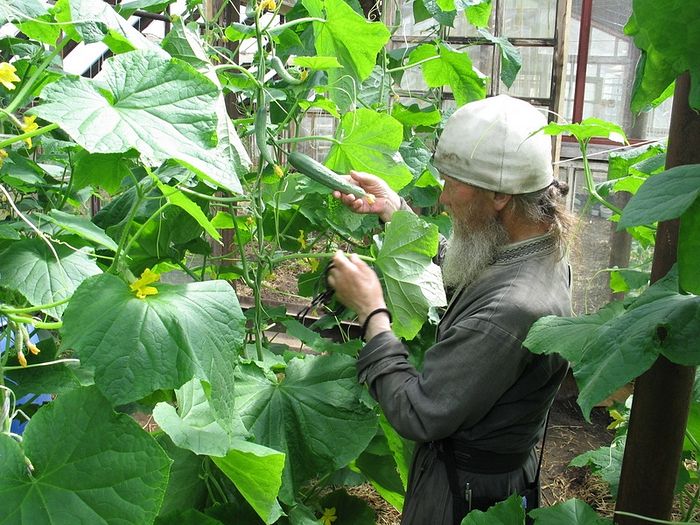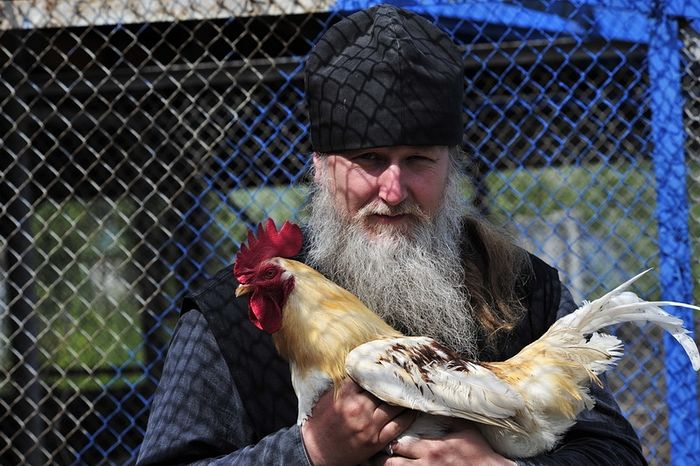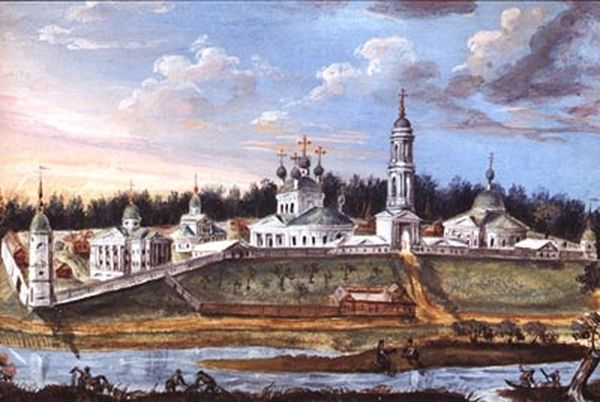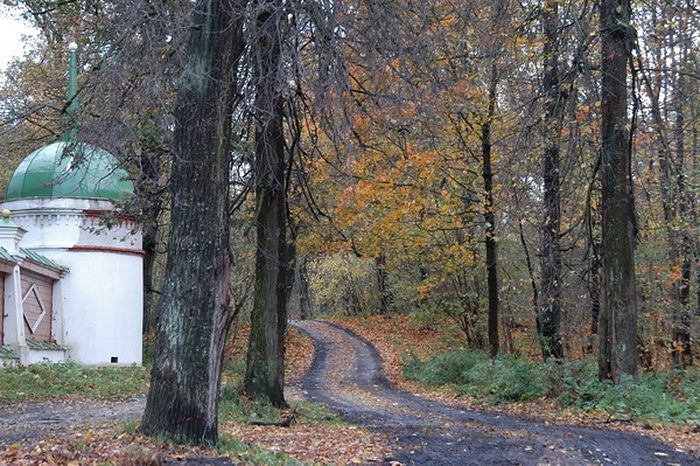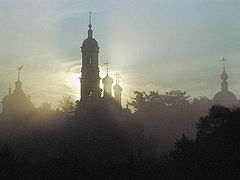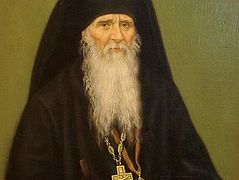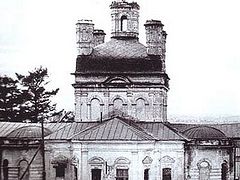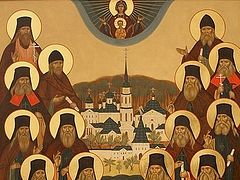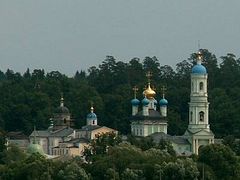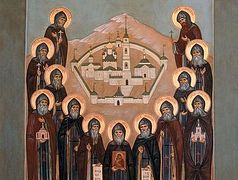Introduction
Optina Monastery is located within a few miles of Kozelsk in the Kaluga region south of Moscow. It is situated on the banks of a rapid river, the Zhizdra, and surrounded by a virgin forest, cutting it off from the world. Externally, the Optina Monastery, with its fort-like walls and towers, and its four churches looks like a grand white kremlin.
The exalted spiritual life of Optina harmonizes with its external beauty. The writer Gogol, after visiting Optina, described its exceptional spiritual atmosphere and benevolent influence upon everyone who came in contact with it.
Gogol left Dolbina, the estate of philosopher l. V. Kireyevsky, with M. A. Maximovitch to visit the nearby monastery of Optina. Two miles before reaching it, Gogol and his travelling companion decided to leave the carriage and continue on foot to the monastery itself. On the way they met a little peasant girl with a bowl of wild strawberries and wanted to buy them from her. But the girl, seeing that they were travellers, did not want to take any money from them and gave them her berries, saying, "It is not right to take anything from travellers on pilgrimage. Amazed by this touching revelation of a child, Gogol remarked, “This monastery spreads piety in people, and I myself,” he continued, “have noticed more than once such an influence from monasteries.”
This is what Gogol wrote to Count A. P. Tolstoy concerning his visit to Optina Pustyn in June, 1850:
''While travelling I stopped off in Optina Pustyn and carried away a remembrance that I shall never forget. I think that on Mt. Athos itself there is nothing better. Grace is visibly present there. One can even sense it clearly in the external serving (in church)…
I have never seen such monks anywhere; with every one of them, it appeared to me, converses everything heavenly. I did not ask them how they live, because their faces speak for themselves. The simplest brothers struck me with their bright angelic kindness, their simplicity of manners, their radiance. Even the workers in the monastery, the peasants and the inhabitants of the neighborhood, struck me in the same way. Several miles prior to reaching the monastery, one senses this spiritual fragrance: everything becomes friendlier, the boughs of the trees are lower, and the attention to a human being much deeper. You should by all means try to visit this monastery. Also don't forget to visit the Abbot in Little Yaroslavets, Antony, who is the blood-brother of the Optina Abbot (Moses) and also renowned for his holy life. The third brother is the Abbot of Sarov and also, they say, a very worthy leader."
Now I want to turn from historic remembrances to my own, and to depict for the reader that picture which once revealed itself to me as I was approaching the monastery. Every time I approached Optina it evoked an irresistible impression in me even from a distance. But there was one particular time when I saw something unusual and unforgettable. I was travelling from the railroad station to the monastery, and suddenly, as we turned, I saw as if suspended in the very air, rising from the ancient forest, a white kremlin, or a city, whose tall white belfry towered over the walls and churches below. All this rose from the ancient forest behind it. A white cloud of fog lay at the foot of the monastery wall, symbolically separating it from the earth, lifting it to the heights. Another white cloud, far away on the horizon, hovered over the monastery, and in that cloud lightnings flickered ceaselessly, as though reflecting the heavenly, uncreated Light of Mt. Tabor, the bearer of which was Optina Monastery.
That was the external impression, but when I settled within the walls and became an Optina pilgrim, my inward sentiments surpassed all my expectations, in spite of the fact that I was relatively well-prepared for that and already knew much from books and had heard stories concerning the Elders from witnesses.
To transmit this impression to one who has not experienced it is impossible! Here is a glimpse:
It is an early summer morning. You are walking to church. There is a fresh breeze. Around you is the wonderful murmur of the deep forest, whose fragrance hovers all over. And in front of you, against the forest, is the grandeur of the white citadel. There is Optina. At the same time, you are experiencing a genuine sense of God's presence, and from this comes fear for each thought, each action, each feeling, together with an intangible peace in your soul, and joy, which so wondrously harmonizes with the external surroundings.
The Significance of Optina Monastery
The significance of Optina Monastery in Russia's spiritual life is very great. It is the best representative of that spiritual revival which Russia experienced in the 18th century.
Located in the midst of the forest and cut off from the world by the river Zhizdra, Optina was an excellent spot for an anchoretic, contemplative life. It was a wonderful spiritual oasis where the charismatic gifts of the first centuries of Christian monasticism flourished anew. These gifts received full expression in the special ministry of eldership, or “starchestvo”. And truly, Optina Elders were renowned for the greatest of all gifts—the gift of discernment, as well as clairvoyance, gifts of healing, and other miracles. This is a prophetic ministry; as in apostolic times it was performed by prophets, so also now the Elders would console the suffering or reveal the future, according to the will of God.
Eldership in Optina takes its beginnings from Schema-Archimandrite Paisius Velichkovsky, that Moldavian Elder who renewed the spiritual "doing" in monasticism, the "native of Poltava.” His successors, led by Hiero-Schemamonk Leo, moved from the Roslavl forests to Optina. Elder Leo, mighty and powerful, begins the whole line of Elders. His disciple, Elder Macarius, who shared his mystical life, directed a group of disciples and men of letters, both monks and lay-people, who translated and turned into literary language the Slavonic translations made by Elder Paisius from Greek—works of great ascetics from ancient times, including Isaac the Syrian, Macarius the Great, and St. John of the Ladder. Under Elder Macarius' influence, the Russian philosopher I. V. Kireyevsky laid the beginnings of a philosophy of "integrity of spirit," which later became the basis of a genuinely autonomous Russian culture.
Optina reached its full bloom during the time of Elder Ambrose, who was a disciple of both Elders Leo and Macarius. The glory of the Elder thundered all over Russia. From all corners of the land people would stream to him. Unusually compassionate, and gifted with the Holy Spirit, he managed to hide his clairvoyance and grace-filled benevolence under the cloak of a joke. He often expressed himself in short aphorisms that rhymed.
During the flowering of Russia and Optina Monastery, thousands upon thousands of people found support and instruction at the Eider's feet. The following Elders continued in the same tradition: his contemporary, Anatole I (Zertsalov), his immediate disciple Joseph, Elder Barsonophius (in the world a military colonel), who became a grace-filled equal to his teachers, and the last Elders: Theodosius the Wise, Anatole the Younger (Potapov), known as the Consoler, and the wondrous Nectarius. The last of them all was Nectarius, who labored during Russia's "trial by fire”, during the Revolution; he quenched the spiritual thirst of believing people, giving them spiritual nectar while himself enduring banishment and persecution.
History of the Origins of Optina Monastery
It is not precisely known when Optina Monastery was founded. According to tradition it was founded in ancient times by a repenting outlaw named Opta. During the persecution of monasteries1 it was closed, and was revived in 1821. But its true flowering begins with the installation of Eldership, which began with the building of the Skete located a few miles from the main monastery.
In 1829 Elder Leonid (1768-1841) arrived. In Schema he bore the name Leo, and it was he who founded Eldership in Optina. Strong-willed, he regally opens the line of great Elders. He is joined in 1834 by Elder Macarius, known for his publishing and translating activity. Under his supervision, patristic writings were translated into Russian and published. But the zenith of Optina's glory was reached by Elder Ambrose, disciple of both Leo and Macarius.
Reconstruction of the monastery itself began only in 1795, when Platon, Metropolitan of Moscow, took notice of it and appointed Hieromonk Joseph as Abbot-builder there; he was followed by Fr. Abramius. Fr. Abramius' presence at Optina came about in the following way: Metropolitan Platon decided he would install coenobitic life in Optina similar to that of Pesnosha Monastery, an outstanding monastery in his diocese. Its initiator was Fr. Macarius of Pesnosha Monastery, a disciple of Theodore of Sanaxar who was in turn in close contact with St. Paisius Velichkovsky, the Sarov Elders, and St. Tikhon of Zadonsk. Metropolitan Platon asked Fr. Macarius to choose one monk from his brotherhood for the task of restoring Optina. Fr. Macarius answered, ''I don't have such men, Your Eminence, unless perhaps I give you my gardener, Abramius."
Abramius was introduced to the Metropolitan. Sickly and humble, he attempted to refuse, but his elders told him that this was the will of God, and Abramius went to Optina.
The monastery was in total disarray. "There wasn't even a towel to wipe your hands on." The brotherhood consisted of three very old monks. In his sorrow Abramius went back to his elder in Pesnosha, who took him along to visit local landowners. As a result, Abramius returned to Optina with two carts filled with things they needed. Elder Macarius sent twelve brothers to help him and the number of monastics began to increase rapidly. Fr. Macarius encouraged and directed Abramius all the time, and the monastery was brought into total good order.
During the War of 1812 the brothers hid in the forested gully and in caves; five years later Abramius died. He was succeeded by Marcellus and Daniel, but Optina came to fruition under the next Abbot, Archimandrite Moses. Externally, more monastery churches were built, living quarters were improved, eight guesthouses were constructed, etc. Besides this, the monastery possessed large orchards, gardens and fields. The main income came from the pilgrims who were attracted to Optina Monastery by its special spirit, so reminiscent of the ancient ascetics of monasticism. But the man responsible for the installation, nurture and preservation of the ancient wisdom, presenting it to the modern age, was Archimandrite Moses, who was himself so aptly called "one of the ancients."2From The Orthodox Word, No. 117 (1984).

